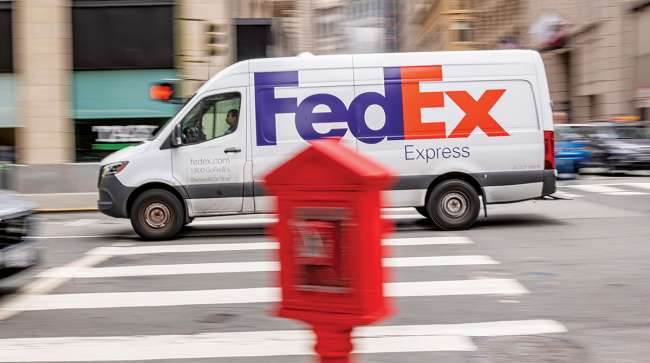Senior Reporter
FedEx Misses Earnings Expectation for Fiscal Q2

[Stay on top of transportation news: Get TTNews in your inbox.]
FedEx Corp. reported it missed analyst expectations for income and revenue when the package delivery giant announced second-quarter fiscal 2024 earnings Dec. 19.
Memphis, Tenn.-based FedEx generated $22.16 billion in revenue compared with $22.81 billion a year ago. The company’s adjusted quarterly income was $1.01 billion or $3.99 a share, compared with $820 million, $3.18, in fiscal 2023’s Q2.
The Zacks Consensus Estimate was for $4.14 per share, and analysts said they expected $22.41 billion in revenue.
FedEx ranks No. 2 on the Transport Topics Top 100 list of the largest for-hire carriers in North America.
The company’s leadership insists that Drive, its long-term cost-cutting plan announced last year that has targeted $4 billion in permanent reductions by fiscal 2025, is working.
“Drive continues to change the way we work,” FedEx CEO Raj Subramaniam said. “The impact of Drive is clear as our lower cost structure enables improved profitability. When you look across market cycles over the last 15 years, we are now dealing with two consecutive quarters of operating income growth against declining revenues.
“When we step back and review how our business has performed in environments with suppressed demand, we are delivering much better profitability today than we have had historically.”
The company also said it now expects a low-single-digit percentage decline in revenue from last year after an earlier forecast of flat revenue results. FedEx also said it intends to repurchase an additional $1 billion in common stock in fiscal 2024 after investors urged the company to lower operating costs and improve profits.
FedEx recently completed a $500 million accelerated share repurchase transaction.
On a conference call with reporters and analysts, the company also explained the restructuring of its FedEx Express international air network in an effort to increase its sagging profits.
FedEx calls the change the tri-color network and divides the unit into purple, orange and white. High-delivery packages will be under the purple label. Orange will emphasize the airfreight segment and deferred package deliveries, which the company said is where much of its air shipment density operates. White will incorporate FedEx’s air partner network.
ERoad's Craig Marris gives advice on carving out a practical, effective road map to a greener and more efficient fleet. Tune in above or by going to RoadSigns.ttnews.com.
Both packages and freight moving under the purple and orange categories will be serviced by the air fleet network, and the orange network also will be connected to FedEx Ground and less-than-truckload unit FedEx Freight in the U.S.
The purple network is being touted as the backbone of FedEx’s International Priority Parcel business.
Officials pointed out that this is the first time there is a connection with the ground network. During the past several earnings conference calls, FedEx leaders have discussed the upcoming changes, but this marks the first time they have spelled out how they believe the new branding and operations will work day to day. Executives also say they want to link the profit profiles of each international air shipment with the right delivery mechanism.
“There is more work to do at FedEx Express, where we are structurally redesigning our network with speed and density,” Subramaniam said. “We continue to make progress at Express to unlock the value that exists across this business.
“These changes will improve utilization of our assets, increase margins and enhance return on invested capital. The air network redesign is a critical piece of our Drive execution at Express and will support the realization of our targeted $4 billion of total Drive savings in fiscal year 2025.”
Want more news? Listen to today's daily briefing above or go here for more info
FedEx Express is the company’s biggest revenue producer, and that division saw a 6% decline in revenue, reporting $10.25 billion compared with $10.86 billion in the previous fiscal year.
Company officials explained that some of the drop-off at FedEx Express is a result of declining volume from the U.S. Postal Service, which is shifting some packages from more expensive air cargo services to less expensive ground transportation.
Revenue at FedEx Freight declined 4% to $2.36 billion from $2.45 billion a year ago. FedEx Services also saw a 4% year-over-year decrease to $65 million from $68 million a year ago.
Revenue at FedEx Ground increased 3% year-over-year to $8.63 billion compared with $8.39 billion.
Two reasons why FedEx Ground saw improved numbers, the company said, were the prolonged contract negotiations between the Teamsters union and FedEx rival UPS Inc. While Atlanta-based UPS and the union eventually reached a deal Aug. 1, FedEx said that during negotiations it gained business from shippers that were concerned a possible strike would disrupt their operations.
FedEx also said it gained market share and business from the summer bankruptcy of LTL carrier Yellow Corp.
“New customers that came over as a result of the shutdown are enjoying a better value proposition, and we have retained a majority of this volume,” FedEx Chief Customer Officer Brie Carere said.





